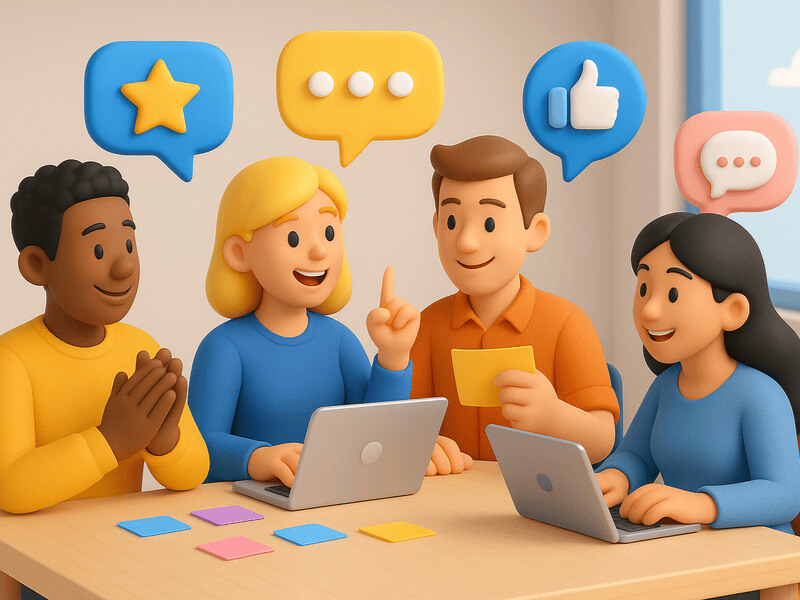
What is a continuous feedback loop?
Are you one of those companies that do surveys regularly, because you're supposed to, but you're never really sure what to do with the data? You might even have a file drawer with all the questionnaires, dutifully filled in by your staff, but you've never bothered to read them because, honestly, who cares whether employee B thinks she needs a bigger desk and employee A is irked that the water cooler is always empty?
Or maybe you did read them, and got B the bigger desk and made sure the water cooler was empty, and then left it at that, convinced that now employee engagement and job satisfaction should be at an all-time high till next year's annual survey?
And then it wasn't, and you swore off surveys for good. Who needs feedback, anyway, when you're doing everything right to start with?
Maybe, just maybe, the issue is with how you're running surveys. Maybe that once-a-year employee experience survey or biannual performance review isn't enough. Maybe it's time to revamp your feedback process, and go with something dynamic and agile, something innovative, something that produces real-time, actionable insights?
Maybe it's time to look into continuous feedback loops.
A continuous feedback loop is an ongoing process in which employees provide continuous input to managers, who in turn take action on that information. In a continuous feedback loop, continuous improvement becomes part of the standard operating procedure for all employees.
Sound good, if a little technical? It's like the 'song that never ends' you may have sung in your childhood, the looping song that just goes on and on my friend. Except, every time the loop goes around, your company gets a little better, a little more productive, a little more focused. And your employees get a little happier, a little more engaged.
The steps of a continuous loop are simple:
- gather feedback
- analyze feedback
- make decisions based on feedback data
- implement decisions
- gather more feedback
- see 2
- see 3
- etc.
Benefits of a continuous feedback loop
Employee feedback loops can benefit your organization in many ways:
- Better performance from employees. An ongoing process of continuous improvement makes sure that there are no slip-ups or forgetfulness, and your employees know exactly what they need to do to exceed customer expectations at all times.
- More engaged employees because everyone is involved in continuous improvement.
- Higher ROI for your customer feedback, employee feedback, or any other survey you pay money to implement. Managers take action on survey results instead of just filing them away or ignoring them.
- Interested employees who want to provide their opinions, rather than angry ones anxious for the end of the survey.
Implementing a continuous feedback loop
Implementing ongoing feedback loops can be as simple as sending out an email survey every week, then brainstorming about the results. Some departments prefer to jump in the deep end, with more complex goal setting and performance management action plans. Usability testing, automated tests, and continuous integration (perhaps powered by machine learning model deployment) can be part of it. It depends entirely on what sort of continuous feedback loop you want to implement, but either way, it's a good idea to start slow and small with continuous feedback loops, rather than trying to implement something complicated from the start.
One way to implement a continuous feedback loop is to set up a continuous improvement board. In this method, managers post ideas for continuous improvement all over the office. Employees vote on their favorite continuous improvement ideas, and management prepares a roadmap and acts on the best ones. Everyone is always learning, and employee performance soars.
Another method is to institute a "Feedback Friday" workplace ritual in which everyone requests feedback from everyone else in the office on Fridays, and sends it too. You'll want to lay out some guidelines before you begin. Keep it constructive, don't forget the kudos, and no personal attacks. Negative feedback is okay, but it should be tempered with a good dose of positive feedback as well. Over time, you'll be able to see how your team has grown in response to your effective feedback loop. While this can be done on paper and pen or in a team meeting, it's even easier to implement with a continuous feedback tool like the free Slack and Teams app Matter.
You can also initiate a customer feedback loop with customer interviews and post-purchase surveys, and high customer satisfaction levels as the end goal.
Of course, even the best feedback loop can't work without continuous action. Whatever method you use, managers will want to constantly schedule time in their workweek to brainstorm with employees about what they can do to improve processes and meet business goals. Continuous testing of production processes can ensure the continuous delivery of a quality product.
A continuous feedback loop for virtual teams
Remote employees may feel left out of the continuous feedback system when they can't see continuous improvement in action around their desks like in-office employees can, but continuous improvement is still possible in a virtual environment.
Here are some tips that may help as you implement continuous feedback in a virtual team:
- Make sure that your managers have a good idea of how they can delegate, empower and facilitate continuous improvement within the context of a team that's scattered across different locations and time zones. A lot of the same rules apply, but continuous improvement in a virtual environment can use some careful planning.
- Rather than rely on social media or emailed feedback, use continuous feedback software to make both giving and receiving feedback easy for your remote employees. Slack, for example, makes continuous feedback simple and easy for virtual teams.
- You can also use knowledge base software to keep both internal team members and customers informed.
- Host regular team meetings where your team can brainstorm on improvements to the big picture. Just because your employees don't come into the office doesn't mean they don't care about what's happening in your organization!
Final tips on a continuous feedback loop
Make continuous feedback a habit. Whether you choose to implement continuous improvement boards, send out surveys every week, or jump in with both feet and do continuous feedback software, just doing it once won't have much effect. You'll have to be consistent about implementing continuous feedback to get continuous results. That's the law of inertia right there!
Implement continuous feedback loops often and immediately. Don't wait weeks or months before asking for continuous feedback. Continuous feedback loops work best when you're constantly listening and responding, not just to employee suggestions but also to problems that may arise along the way.
Don't expect perfection: continuous improvement courses work best when there's room for your employees to experiment and make mistakes along the way. Sometimes continuous improvement comes from finding out what doesn't work!
In conclusion, continuous feedback loops can be an easy and effective way to improve your business processes and constantly improve workplace culture. Implement a continuous feedback loop the easy way today with continuous improvement boards, continuous feedback software, or a "Feedback Friday" ritual for your office.
Any way you choose to implement continuous feedback loops in your organization, make sure to keep the continuous action going by constantly creating a culture of continuous improvement. Sure, it takes effort, but the results are well worth it!
























